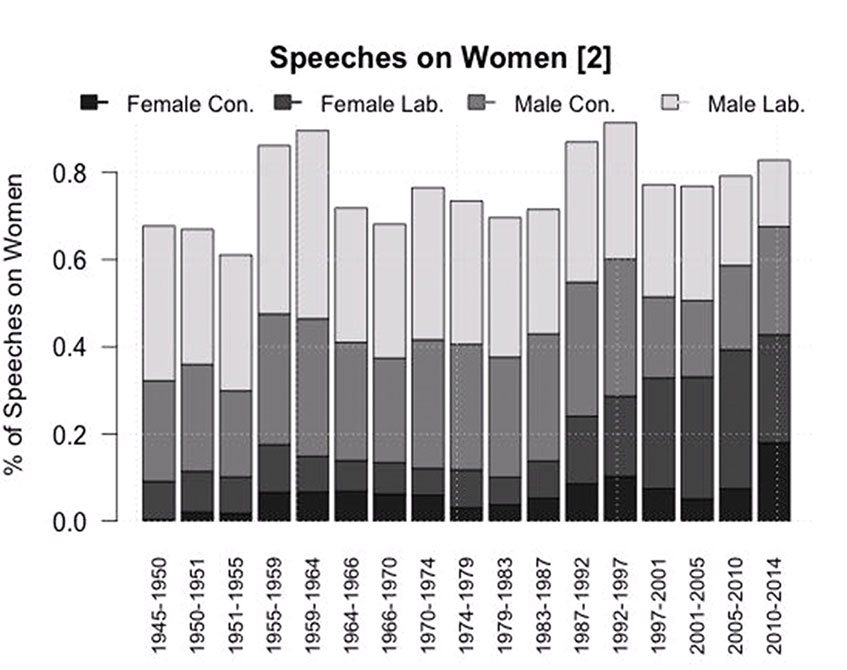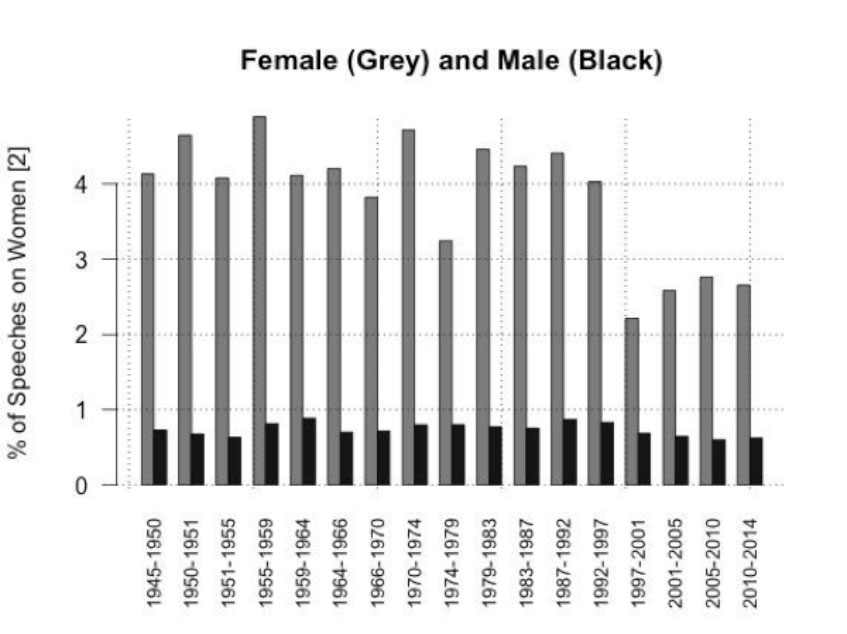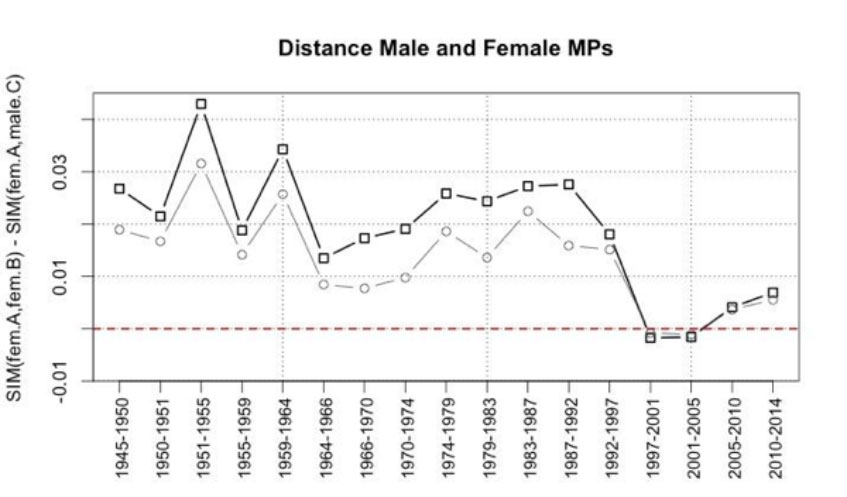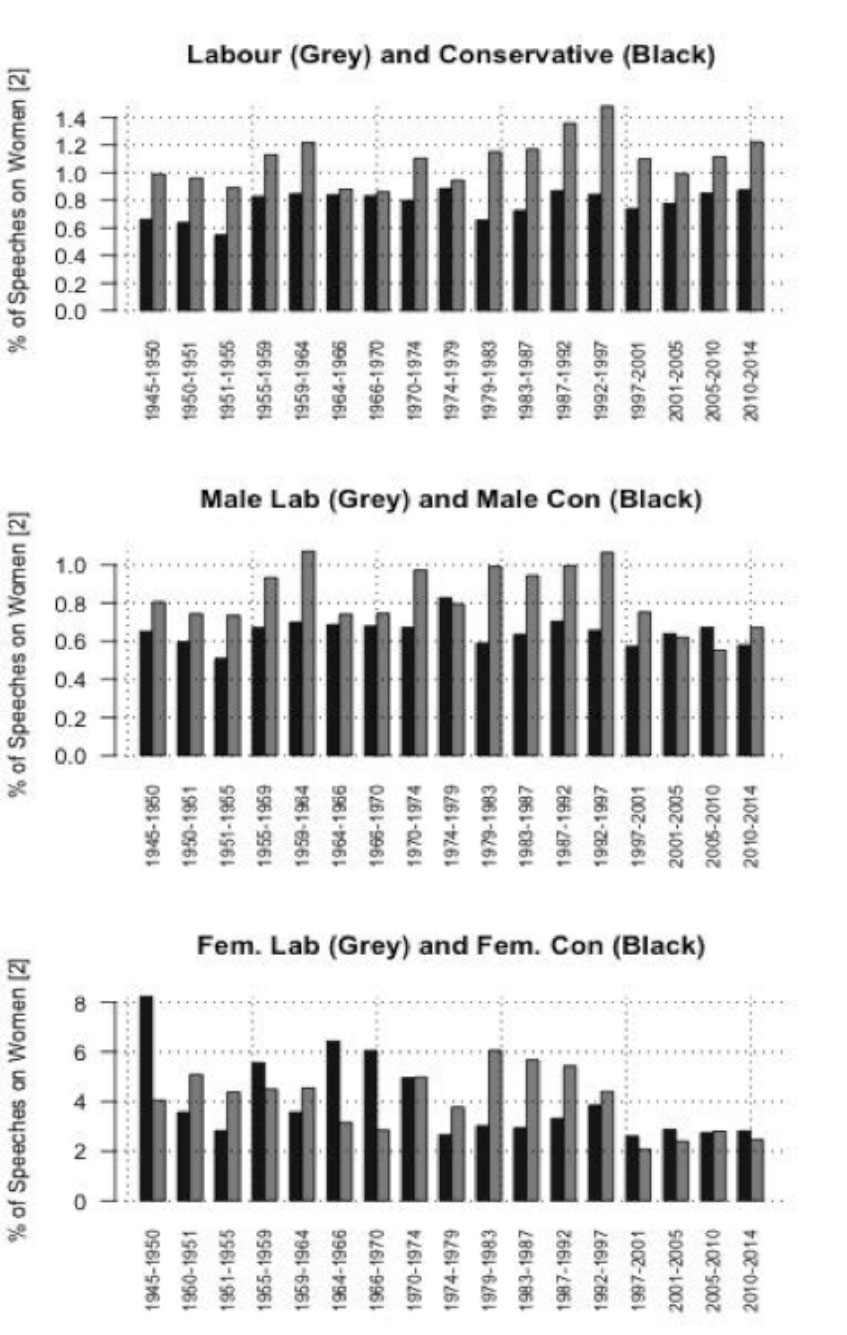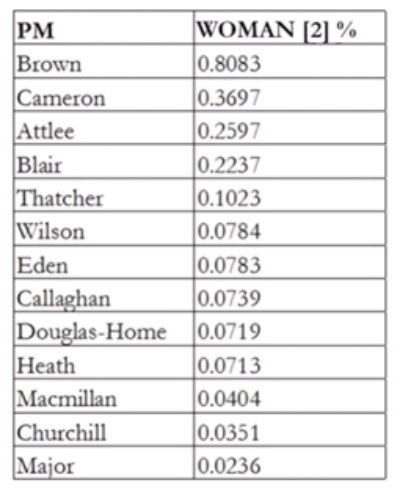INTRODUCTION
The debate on women’s representation at Westminster is well-established. Usually, it centres around the question of numbers. Women are 51% of the population, but make up less than 30% of the House of Commons, even after a record number were elected in 2015. As Figure 1 shows, women MPs have made up a tiny proportion of the House for most of the period since 1945.
Figure 1: The percentage of women in the House of Commons per parliament, 1945-2014.
Commentators, politicians and academics have argued extensively about the reason for the persistence of this imbalance. Some contend that it is a reflection of deep-rooted sexism at parliamentary and constituency party level, and that the Commons remains an ‘old boy’s club’ which perpetuates adversarial ‘Punch and Judy’ and ‘yah boo’ politics that women find particularly off-putting. Others suggest that the nature of parliamentary life, with long, antisocial working hours, makes the gender gap comparable to that seen in other high-pressured occupations such as finance, which men also continue to dominate. By contrast, there are those who point to the steadily increasing female presence in the House since 1992 and argue that equalisation is happening – and rapidly – but that we are not quite there yet.
A crucial underlying question is precisely why it is important that Parliament should resemble the population in terms of gender. Often it is asserted that Parliament physically resembling the people – be it in terms of sex, race, class, sexuality, and disability – is an absolute egalitarian good in itself, although parties disagree on what measures they are prepared to take to achieve it, especially over positive discrimination. This is what is known as ‘descriptive representation’.
A deeper question, however, is whether representation is a question of minds as well as bodies. Do women MPs actually behave differently to men in Parliament, and represent women in a way that their male colleagues do not? This question – that of ‘substantive representation’ – continues to vex commentators and academics alike. If it can be demonstrated that women contribute something different beyond their simple presence – a less adversarial political style, a focus on legislation of especial interest to women such as child welfare and equal pay, or a greater willingness to bring their own gendered life experiences to bear in parliamentary debate – then the argument for gender equality in Parliament is considerably strengthened.
THE DEBATE SO FAR
The debate amongst academics on substantive representation is well-developed. Thus far, the vast majority of commentators conclude that women – in Westminster and in Parliaments around the world – have behaved demonstrably differently to men in most areas of parliamentary life.
Historians have examined the careers of famous MPs such as Ellen Wilkinson, Nancy Astor, Marion Phillips, and others. They find that women parliamentarians were often forced to occupy a separate metaphysical space concerned with social and welfare questions, and to avoid foreign policy, economics, and other ‘hard’ topics. During a debate on widows’ pensions in 1928, Wilkinson complained that being bombarded with letters from women left her little option but to act as ‘the member for widows rather than the member for Middlesbrough’, whilst Labour MP Herbert Morrison advised Lena Jeger in 1953 that her maiden speech should ‘stick to women’s issues’. Studies of later decades – such as Elizabeth Vallance’s insightful Women in the House (1979) – also found that ‘women’s problems and concerns were relegated to a kind of ghetto area’. Indeed, Harriet Harman recently wrote that she and other Labour women in the 1980s had been advised to steer clear of women’s issues to avoid being ‘pigeon-holed’.
Political scientists, on the other hand, have investigated differences between male and female MPs in Westminster and many legislatures around the world in the postwar period. Some have interviewed women MPs to ascertain their professed priorities relative to male colleagues, while others have investigated their work on select committees, in constituency casework, or their roles in piloting ‘women’s issues’ bills. Where political scientists have made policy recommendations, they have generally advocated the use of affirmative action mechanisms such as all-women shortlists to redress the gender imbalance, and proposed measures that might help alter the confrontational masculine environment of the Commons and make it more ‘female-friendly’. Such recommendations have sometimes been based on Rosabeth Kanter’s ‘critical mass’ theory, which predicted that women from different parties would begin to co-operate across party lines once they comprised a large minority (at least 20%) of the House, a threshold achieved and sustained in Britain since the 1997 election.
CHALLENGES AND PROBLEMS
We argue that there are five major problems with the research underpinning contemporary debates over women’s representation.
The first is simply that there is too much data: the 0.7 billion words spoken in the Commons since 1945 (recorded in Hansard, the official record of the Houses of Parliament) would take an estimated 22 years for a single researcher to read, let alone analyse, in totality.
The second is that the majority of previous work has examined women in isolation and paid little attention to men. This makes firm conclusions hard to draw. For example, the claim that women MPs have prioritised welfare legislation since 1945 is hardly meaningful if the same was also true for men.
The third problem is the tendency to define women’s substantive representation – and indeed feminism – in terms which are intuitive to the left, but not necessarily to the right. This stems partly from the fact that there have been many more Labour than Conservative women MPs since 1945, which has meant (for example) that women MPs’ prioritisation of anti-discrimination legislation, greater social spending on welfare, and a pro-choice abortion policy, may reveal more about the Labour party than it does about gender.
The fourth problem – stemming from both the second and third – is that many scholars take as their starting point the assumption that the substantive representation of women rests on articulating gender difference. But this in itself is contentious, because many female politicians on both right and left (such as Margaret Thatcher, Barbara Castle, Betty Boothroyd, and Ann Widdecombe) clearly viewed the absence of a politicised ‘women’s interest’ as evidence that they were being represented on equal terms to men.
The fifth and final problem is that any preconceived definition of women’s substantive representation – or women’s ‘issues’ or ‘interests’ – is itself problematic because it can lean towards the dangerous assumption that women necessarily share particular common priorities and characteristics because they are women.
A New Perspective
This policy paper presents the results of a novel computerised study on the speaking patterns of women in Parliament which aims to overcome all five of the problems outlined above. We ask the following the questions:
Are women in Commons debates likelier to speak about women than men, and are there topics which women are more likely to raise?
How have these patterns changed since 1945, and have gendered differences widened or narrowed as more women have entered the House, especially since 1997?
What are the effects of party? Have Labour female MPs been more likely to speak about women than Conservative female MPs?
While we make no policy recommendation, we hope that our results can contribute to the long-running debate on women’s representation by adding hard, empirically-derived historical data to the discussion.
A New Methodology
We use computational methods (known as ‘text mining’) to compare the vocabulary of female and male MPs. This is made possible by a recent project called ‘Digging into Linked Parliamentary Data’ (http://dilipad.history.ac.uk) which allows us to automatically identify the gender and party affiliation of all MPs making speeches in the Commons, as recorded in Hansard.
Using text mining, we are able to analyse in seconds or minutes what a human researcher would struggle to achieve in years. Moreover, computers allow us to avoid pre-defined schemas of women’s ‘issues’ or ‘interests’ (i.e. predefining what sort or topics and vocabulary constitute the substantive representation of women) and simply treat all text as data. This allows us to derive gendered language differences empirically, by studying what male and female MPs actually said. In addition, our approach also allows us to control for numerous variables which might distort a simple comparison between male and female parliamentarians, such as party, ministerial rank (including occasions when one woman – such as Margaret Thatcher – disproportionately contributed to the totality of female speeches simply because she was Prime Minister), and the seniority of MPs (women MPs have generally had shorter political careers, and newer MPs of whatever gender are likelier to speak less often and be more loyal to the party whip).
Text mining has very seldom been used by historians, partly because texts like Hansard have only recently been digitized, but also because a mechanised empirical approach of this kind is entirely divorced from the intuitive ‘feeling’ derived from actually reading speeches. While often cited as the primary weakness with text mining, it can also be seen as its greatest strength. Rather than condemning us to select a few isolated leaves from a huge forest and interpret them according to our biases, text mining simply delivers cold numerical data about the whole text. It isn’t necessarily a better approach to language analysis, but it can enable us to discover and measure general patterns in a huge text which would be impossible for a human scholar reading manually.
Extensive methodological notes on all of the analyses here can be found in the peer-reviewed journal article on which this policy paper was based (‘ A Feminised Language of Democracy? The Representation of Women at Westminster since 1945’, Twentieth Century British History, 2016).
A shorter methodological note appears at the end of this piece.
Our Findings
The first part of our analysis tracks how often women were mentioned by MPs giving speeches in the Commons. Our mechanism for this is to count speeches which include at least three hits for a broad range of words which are synonymous with women, for example ‘women’, ‘woman’, ‘female’, ‘widow’, ‘mother,’ and so on (see methodological note at the end for a full description). We call this range of words ‘Women [2]’. We considered a speech satisfying these criteria as being ‘about women’ for the purposes of this analysis. This is inevitably an imperfect tracking mechanism, but it does allow us to make broad comparisons over time. We tracked these words for each Parliament, excluded the speeches of ministers, and subdivided the results by both party and gender, as shown in Figure 2 below:
Figure 2: Bar chart to show the contributions of different groups of MPs to the total percentage of speeches about women.
Figure 2 allows us to compare the parliament-by-parliament fluctuations of mentions of women. An early peak occurs in 1955-64, during the Conservative ministries of Eden, MacMillan and Douglas-Home, which was not exceeded until Major’s 1992-97 government. Interestingly, Harold Wilson’s Labour ministries of 1964-70 – despite coinciding with the rise of the Women’s Liberation Movement, the advent of the so-called ‘permissive society’, and featuring high-visibility debates on equal pay, abortion, and divorce – saw a marked decline in the attention given to women in speeches. This increased very slightly throughout the 1970s and during Thatcher’s first two terms. The 1987-92 parliament registers a considerable spike, however, and this rises still further during Major’s 1992-97 ministry, which achieves the high watermark for the period. The proceeding three Labour terms under Tony Blair and Gordon Brown – despite featuring record numbers of woman MPs – registers a slight decline, which is partially redressed under David Cameron’s coalition from 2010.
Another striking feature is that in all parliaments until 1997, most of the speeches mentioning women were made by men. Although (as we will see) women MPs individually were considerably more likely than men to make speeches about women, their status as a small minority group meant they were heavily outscored in absolute terms by male colleagues. This distribution begins to alter in 1987, where women take an increasingly large share of the absolute number of speeches, and they finally overtake men in 2005. Labour, with their greater number of women MPs, were largely responsible for this change. While these trends are primarily a product of the increasing female presence in the House, it is important to note that the arrival of a large cohort of women MPs after 1997 did not increase the overall number of speeches made about women. More were made during 1955-1964 and 1987-97.
A still more useful visualisation, however, is Figure 3 below, which shows the percentage of speeches about women made by male and female MPs. It shows that just over 4% of the speeches of female MPs in the 1951-55 Churchill ministry were about women, compared to approximately 0.5% of those of male MPs, meaning that female MPs in this parliament talked about women around eight times as often as male colleagues.
Figure 3: Percentage of speeches about women contributed by male and female MPs, 1945-2014.
This finding, while not surprising in itself, provides strong prima facie corroboration of the central feminist claim that female representatives – in almost any context – are much more likely than male colleagues to focus on women. Indeed, although this contention has remained largely implied rather than proven by historians and political scientists, it seems likely that this ‘gender gap’ may be still larger than that anticipated even by feminist scholars. However, we do also see that, after 1997, this longstanding gap has narrowed considerably.
While interesting, simply tracking mentions of women in Parliament is a relatively crude index for women’s substantive representation. Figure 4 below takes a different approach, and explores whether – regardless of whether women are explicitly mentioned or not – there are systematic differences in the issues female legislators raise, as indicated by their choice of vocabulary. To explore this, we generated (for each of our seventeen parliaments) two ‘hit lists’ of words that women used consistently more than men and vice versa, according to a test of statistical significance. By combining these 34 lists, we produced a table of the ‘most female’ and ‘most male’ words throughout the whole period. For example, ‘child’ was used significantly more often by women in every parliament from 1945 onwards, whereas ‘argument’ was used significantly more often by men in 82% of the parliaments (fourteen) but not in the remaining 18% (three). Of course, for the vast majority of words uttered in the Commons in these seventy years, there was little or no difference between the sexes (i.e. they register significant difference in 0% of Parliaments) so even the words at the foot of this table (‘teacher’ for woman and ‘conclusion’ for men) are still strongly gendered words in comparison to the vast majority of others.
Figure 4: Words that are used consistently more often by either female (left) or male MPs (right), 1945-2014.
These results are immediately striking. There are two words which were used more often by women in all seventeen parliaments, five that fit this description for sixteen parliaments, and eight that fit it for fifteen. Amongst men, there are just two words (‘argument’ and ‘force’) which appear more often in fourteen parliaments, and none for fifteen, sixteen, or seventeen, meaning that women have nineteen strong gender markers in the space where men have two. Indeed, 42 words are used significantly more by female MPs in at least 65% (eleven) parliaments, whereas only nine words fit that description amongst male MPs. In other words, women MPs utilise a shared vocabulary to a much greater extent than men.
Looking at the words themselves, Figure 5 also provides strong evidence that gender is much more subtly manifested than women MPs simply talking about women or using explicitly gendered terms. Alongside words like ‘girl’, ‘daughter’ and ‘mother’, other domains emerge, including the family and children (‘family’, ‘husband’, ‘marriage’, ‘parent’, ‘child’, ‘baby’, ‘nursery’); education (‘teacher’, ‘training’, ‘school’); health (‘clinic’, ‘nursing’, ‘doctor’, ‘patient’, ‘medical’, ‘nurse’, ‘treatment’, ‘bed’); and care in general terms (‘help’, ‘care’). Male MPs, on the other hand, are much likelier to refer to the parliamentary debate itself, especially conflicts within it (‘proposition’, ‘wrong’, ‘principle’, ‘doubt’, ‘party’, ‘argument’, ‘view’, ‘point’). Other consistent masculine markers include the military and vehicles (‘aircraft’, ‘ship’, ‘weapon’, ‘troop’, ‘military’, ‘defence’); business (‘corporation’, ‘business’, ‘expenditure’); foreign policy and geography ( ‘Germany’, ‘Americans’, ‘northern’, ‘international’, ‘foreign’, ‘western’, ‘sea’). Overall, it is hard to escape the conclusion that this data resoundingly confirms the sharply-gendered and stereotyped qualities and policy priorities which have traditionally been associated with male and female politicians.
Convergence since 1997?
While the gender differences suggested above are revealing, the historical fluctuations are perhaps still more so. Figure 3 shows a remarkably constant volume of speeches about women – from both male and female MPs – in the 34-year period from Attlee to Thatcher. For the four Conservative governments after 1979, we see a noticeable increase amongst women MPs, accompanied by a smaller rise amongst their male colleagues. But most significantly, we see a small but marked decline after 1997 both in the proportion of speeches about women but especially in the propensity of female MPs to speak about women. Indeed, an analysis of all of the ‘female words’ in Figure 4 also reveals that women in pre-1997 Parliaments were likelier to use these words more often.
The identification of 1997 as a turning point is significant because the number of women in the House nearly doubled at this election. However, it would appear that female parliamentarians were in fact less likely to prioritise the substantive representation of women than they were previously. Differences between male and female MPs – while still very much in existence – were arguably being eroded by the increased presence of women in the House. This is further corroborated by Figure 5, which measures convergence by calculating whether a randomly selected female MP’s vocabulary was more similar to another randomly selected female MP, or a randomly selected male MP.
Figure 5: Graph to show the difference in vocabulary between male and female MPs, 1945 to present. The black line is the mean, the grey line the median. Their convergence towards the red dotted line on the x-axis suggests that differences between male and female MPs tend to disappear
While Figure 5 is rather an abstract measure, it is illuminating. The periods of greatest difference between the language of male and female MPs are in the immediate post-war decades. We see a substantial drop in 1964, followed by a relatively stable period holding until 1997, followed by a further dramatic drop and the virtual elimination of gendered vocabulary difference. This shift is generally sustained during the four subsequent parliaments after 1997. It is important to note this is not a story of the ‘masculinisation’ of women’s language, because some of this convergence is undoubtedly accounted for by changes in men’s language.
While more research in this area is needed, it seems likely that 1997 was significant because the large group of women elected helped absolve female MPs of the obligation – widely cited by many of their predecessors – to act as spokeswomen for their sex. It seems fair to hypothesise that the advent of a more balanced House of Commons, where interactions between male and female parliamentarians became unremarkable daily business rather than a novelty, has caused both sexes’ language patterns to move towards each other.
A Question of Party?
A final important point is party. While Labour consistently had more women MPs than the Conservatives, did Labour women make more speeches about women, or make substantively more use of the ‘female words’ shown in Figure 4?
The top two bar charts in Figure 6 show that Labour MPs did contribute proportionally more speeches about women than Conservatives MPs in all but two of the parliaments. They also contributed more of the ‘female words’ shown in Figure 4 in all but three parliaments. Labour’s leads are strongest in the period since 1979. This provides face-value support for the widely made argument that from the 1980s the Labour party – with its greater ideological sympathy to feminism, higher proportion of women MPs, and adoption of all-women shortlists from 1993 – gave greater attention to the substantive representation of women than the Tories. The emergence of a gender gap in voting behaviour since 1979 also seemingly supports another common argument: that the Conservatives under Thatcher adopted a more ideological, meritocratic, opportunity-focussed discourse rooted in gender neutrality, which shared their leader’s outspoken disapproval both of feminism, and of identity politics in general.
However, when we break down the party data by gender this interpretation becomes problematic. e discover that Labour’s advantage is mostly amongst male MPs, who lead Conservative men in 12 Parliaments in their propensity to speak about women, and also in mentions of the ‘female words’ from Figure 4. Amongst women, we find a more even breakdown, with the average Labour women often trailing, or equalling, Conservative women before 1974, before generally leading thereafter. Viewed in total, there is no statistically significant difference between the parties overall, whilst party status – that is, whether the party was in government or opposition – was in fact more important than party itself.
The weakness of Labour’s advantage, even in recent decades, is further emphasised if we isolate MPs who were originally selected from all-women shortlists. We might expect this group of 86 MPs (elected in 1997, 2005, and 2010) to be the most predisposed to speak about women and women’s social perspective. However, our research found only a tiny and statistically insignificant positive effect amongst this group.
Finally, if we also look at Prime Ministers’ propensity to speak about women (see Figure 7) or use our female words, we find that Thatcher – while trailing the three most recent premiers and Attlee – nonetheless outscores all of her other Labour and Tory contemporaries. This is perhaps most surprising in the case of Wilson, who had a reputation as a keen champion of women and oversaw the Equal Pay Act, Abortion Act, and Divorce Reform Act during his premiership. Overall, this data does not seem to support the conventional argument that Labour prioritised women’s substantive representation in debate more than their Conservative opponents for any sustained period after 1945.
Figure 6: Graphs to show percentage of speeches containing at least three mentions of women by party, and by both party and gender
CONCLUSIONS
Our findings point in two directions. On the one hand, proponents of affirmative action on the grounds that women speak a different political language to men find support from our analysis. As we have seen, there is strong evidence of gendered differences in the language used by male and female MPs in Parliament. From this it may reasonably be concluded that if the number of women MPs further increases, the priorities associated with this group are likely to be more powerfully emphasised in Parliament at the expense of ‘masculine’ priorities.
On the other hand, we also suggest that this may be a question of diminishing, rather than increasing returns. Rather than creating a stronger women’s parliamentary lobby where gender differences could be more sharply articulated, women’s entry to the Commons in large numbers since 1997 helped normalise a significant female parliamentary presence. The effect was to erode, rather than entrench, the sharp demarcation of gender boundaries that had characterised parliamentary life and debate since women’s entry to the Commons in 1919. While the persistence of strong gendered differences in parliamentary language remind us that the demarcations still very much exist, there is stronger evidence that the direction since 1997 has been towards convergence rather than divergence, whereas the same could not be said for the previous 52 years. Overall, we suggest that further increasing the number women to Parliament has the capacity to feminise parliamentary debate further, but that it is likely to represent a question of diminishing returns. Put simply, stronger advocacy of feminism and ‘women’s issues’ are unlikely to arise as an automatic consequence of adding women to the Commons benches.
Finally, our evidence suggests that the Conservative party from 1979 ha been wrongly sidelined in the debate over women’s political representation. Empirically, we find no evidence to suggest that Tory female MPs spoke less about women than their Labour contemporaries. That their claims to represent women may have been articulated in a conservative – as opposed to feminist – accent should not discount them.
A METHODOOLOGICAL NOTE
Our measure ‘Woman[2]’ (which we use in Figures 2,3 ,6, and 7) is a broad set of semantically related words, which appear frequently in Hansard, and unambiguously refer to women. We included hits for the following words: ‘women’, ‘woman’, ‘female*’, ‘widow’, ‘widows’, ‘*mother*’, ‘girl*’, ‘wives’, ‘wife’, ‘sister*’, ‘daughter*’, ‘lady’, ‘ladies’, ‘femin*’, ‘matern*’. The asterisks indicate a ‘wildcard’ search. We focussed on words that are related to social classifications, but excluded words which could appear in forms of address such as ‘hon. Lady’, or which are ambiguous in this respect (e.g. ‘miss’, which could refer to missing a target, or ‘she’, which might refer to an ocean liner or a country). We also excluded forms of address because their frequency would, self-evidently, simply increase in proportion to the number of female MPs in the Commons and fails to capture attention given to women as a topic of discussion. We refer to ‘statistical significance’ a number of times in the paper. Statistical significance – or the P Value – is the probability that an observed correlation exists only by random chance: the ‘null hypothesis’. We use the standard benchmark for significance, which is a P value of 0.05 (a ≤5% chance that the null hypothesis is true).
While the graphs above show simple ratios and averages, we have also tested these trends with extensive statistical modelling and regression analysis, which allows us to be more confident that the have isolated gender as the casual factor, and are not conflating it with others variables such as party, length of parliamentary career, and whether the speaker was a minister or a backbencher.

